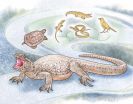(Press-News.org) Amsterdam, September 3, 2015 - 3D imaging of a mummified kestrel that died due to forced overeating provides evidence that the ancient Egyptians bred birds of prey as offerings for the gods, according to a new study published in the Journal of Archaeological Science. The digital CT imaging revealed that the kestrel was force-fed its last meal - a mouse - suggesting it was kept in captivity.
This is the first evidence to point to mass breeding of raptors as offerings to gods. The researchers behind the study, from the American University in Cairo, Stellenbosch University and the Stellenbosch Institute for Advanced Studies say their findings also have implications for the use of birds of prey in falconry for hunting.
Animal mummies were common in ancient Egypt and used in religious ceremonies, often as offerings. Millions of mummified animals have been found, most dating from around 600 BC to AD 250. Ancient Egyptians believed in many gods and associated different animals with them; raptors like kestrels were connected to the sun god Re.
"The idea of birds of prey being bred to the extent of being kept and force-fed is new," said Dr. Salima Ikram, Professor of Egyptology at the American University in Cairo and lead author of the study. "Until now, the sheer number of raptor mummies had been a mystery - did they catch or trap them and kill them, raid nests, or find them dead? Our results explain why they had so many: we now think it was because of active breeding."
In ancient Egypt, birds used as votive offerings were prepared by being gutted and dried, then dipped into molten resin and wrapped. However, sometimes the birds were not gutted, giving the researchers a chance to take a glimpse into one particular bird's life before it died.
The researchers carried out a virtual autopsy on a bird mummy from Iziko Museums of South Africa in Cape Town. The bird mummy, SACHM 2575, was scanned using CT imaging and the team created 3D images of the bird. Based on morphology, limb measurements and beak shape, they established it was a European kestrel (Falco tinnunculus).
Since the bird had not been gutted prior to mummification, they could also look into its digestive tract to see what its last meal had been. They found the tail of a young house mouse (Mus musculus), which appears to have caused the kestrel to choke to death. Looking further into the gizzard and stomach, they found other mouse fragments, including 27 loose teeth, suggesting that the kestrel had eaten more than one mouse earlier in the day. They also found parts of a small sparrow.
"This was one of the most entertaining and exciting bits of research to do - when we saw how much the kestrel ate and how it choked, we suddenly had an idea about how the ancient Egyptians managed to mummify so many raptor and the implications about wild animal husbandry and the possibility of falconry being practiced in ancient Egypt," said Prof. Ikram.
"We know raptors were religiously important but it's interesting to think about the role they may have had in falconry. It's also interesting that Egyptians were exerting so much thought and control over nature and that their aptitude with wild animals is considerable."
The findings open the door to further work to distinguish the different breeding groups by analyzing the DNA of the raptors and determining their sex. The researchers say this will provide a deeper understanding of the role of raptors in ancient Egypt and explain how the Egyptians saw nature and their role in it.
INFORMATION:
Read more on: Elsevier Connect
Article details
"Fatal force-feeding or Gluttonous Gagging? The death of Kestrel SACHM 2575" by Salima Ikram, Ruhan Slabbert, Izak Cornelius, Anton du Plessis, Liani Colette Swanepoel, Henry Weber (doi: 10.1016/j.jas.2015.08.015). The article appears in Journal of Archaeological Science, Volume 63 (November 2015), published by Elsevier.
A copy of the paper is available to credentialed journalists upon request, contact Elsevier's Newsroom at newsroom@elsevier.com or +31 20 4853564.
About Journal of Archaeological Science
The Journal of Archaeological Science is aimed at archaeologists and scientists with particular interests in advancing the development and application of scientific techniques and methodologies to all areas of archaeology. The journal publishes papers that present major advances in scientific methods and techniques in archaeology, showcase innovative science, shape global debates, address questions of broad significance and describe studies with far-reaching applicability. http://www.journals.elsevier.com/journal-of-archaeological-science
About Elsevier
Elsevier is a world-leading provider of information solutions that enhance the performance of science, health, and technology professionals, empowering them to make better decisions, deliver better care, and sometimes make groundbreaking discoveries that advance the boundaries of knowledge and human progress. Elsevier provides web-based, digital solutions -- among them ScienceDirect, Scopus, Elsevier Research Intelligence and ClinicalKey -- and publishes over 2,500 journals, including The Lancet and Cell, and more than 33,000 book titles, including a number of iconic reference works. Elsevier is part of RELX Group plc, a world-leading provider of information solutions for professional customers across industries.
http://www.elsevier.com
Amsterdam, September 3, 2015 - Elsevier, a world-leading provider of scientific, technical and medical information products and services, has announced that its Reviewer Recognition platform has launched a new functionality which enables reviewers to list their entire review history, including their reviews for non-Elsevier journals, in one place online. It also allows them to share their Reviewer Page publically - increasing visibility and recognition of their work.
Through the Reviewer Recognition platform, Elsevier reviewers already have access to a personal review ...
A 260-million-year-old fossil species found in South Africa's Karoo Basin continues to provide information into the murky origins of turtles whose evolution fascinates scientists.
The fossil of an extinct reptile, named Eunotosaurus africanus, is the earliest known branch of the turtle tree of life.
"Eunotosaurus is a critical link connecting modern turtles to their evolutionary past," says Dr Gaberiel Bever an Honorary Research Associate at Wits University's Evolutionary Studies Institute (ESI) and scientist at the New York Institute of Technology.
Previous studies ...
UK fisheries survey logbooks from the 1930s to 1950s have been digitised for the first time, revealing how cod responded to changing temperatures in the last century.
Scientists at the Centre for Environment, Fisheries and Aquaculture Science (Cefas) and the University of Exeter found that at the time, the warm seas experienced around Norway benefitted the cod, similar to the conditions there today.
Most cod eaten by the UK comes from northern seas including the Barents Sea around Norway, because the stocks there at the moment are at record highs. Cod stocks were also ...
Study examines trees in Leicester City
Pollution levels for pedestrians reduced by seven per cent in city environment
Highlights importance of trees in urban planning decisions
Trees in cities throughout the UK could be significantly improving the quality of the air we breathe by decreasing pollution levels for pedestrians, researchers from the University of Leicester have revealed.
The team from the University of Leicester's Department of Physics and Astronomy found that trees have a regionally beneficial impact by increasing turbulence and reducing ambient ...
In the first study of its kind, new research from the University of New Hampshire shows that crop rotations, in isolation from other management factors, can increase the functions performed by soil microbial communities that benefit plant growth. The study was conducted by researchers with the New Hampshire Agricultural Experiment Station.
The study was conducted by Lisa Tiemann, former postdoctoral student, Stuart Grandy, who was Tiemann's postdoctoral advisor, and Marshall McDaniel, former postdoctoral student of Grandy, all of the UNH Department of Natural Resources ...
Philadelphia, PA, September 3, 2015 - People diagnosed with schizophrenia critically rely upon treatment with antipsychotic medications to manage their symptoms and help them function at home and in the workplace.
But despite their benefits, antipsychotic medications might also have some negative effects on brain structure or function when taken for long periods of time.
In fact, "the role played by antipsychotic treatment on the pathophysiologic trajectory of brain abnormalities in schizophrenia is currently a matter of lively debate," explains Dr. Antonio Vita, Professor ...
CAMBRIDGE, Mass.--Researchers at MIT have developed a family of materials that can emit light of precisely controlled colors -- even pure white light -- and whose output can be tuned to respond to a wide variety of external conditions. The materials could find a variety of uses in detecting chemical and biological compounds, or mechanical and thermal conditions.
The material, a metallic polymer gel made using rare-earth elements, is described in a paper in the Journal of the American Chemical Society by assistant professor of materials science and engineering Niels Holten-Andersen, ...
A sophisticated imaging technique has allowed scientists to virtually peer inside a 10-million-year-old sea urchin, uncovering a treasure trove of hidden fossils.
The international team of researchers from the United Kingdom, Spain and Germany, including Dr Imran Rahman from the University of Bristol, studied the exceptional specimen with the aid of state-of-the-art X-ray computed tomography (CT).
Their results show that the sea urchin fossil was riddled with borings made by shelled invertebrates called bivalves.
These fossilized boring bivalves were preserved inside ...
WASHINGTON, DC (September 3, 2015)-- The District of Columbia's needle exchange program prevented 120 new cases of HIV infection and saved an estimated $44 million over just a two-year period, according to a first-of-a-kind study published today by researchers at the Milken Institute School of Public Health (Milken Institute SPH) at the George Washington University.
"Our study adds to the evidence that needle exchange programs not only work but are cost-effective investments in the battle against HIV," says Monica S. Ruiz, PhD, MPH, an assistant research professor in ...
Voriconazole, a prescription drug commonly used to treat fungal infections in lung transplant recipients, significantly increases the risk for skin cancer and even death, according to a new study by UC San Francisco researchers. The team recommends physicians consider patient-specific factors that could modify the drug's risks and benefits, when providing care.
Their study appears online Sept. 3, 2015, in the American Journal of Transplantation.
"It is important for physicians to be aware of the impact of voriconazole on these outcomes," said senior author Sarah Arron, ...


